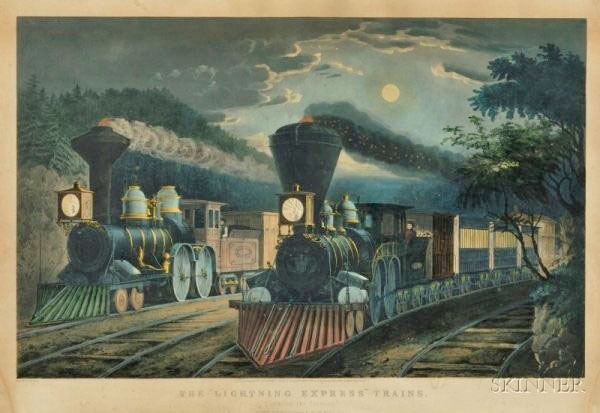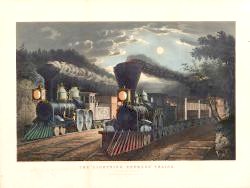The Lightning Express
“Hurry!! She’s a comin, right now!”
Henry Jarrett was a partner in the firm of Jarrett & Palmer that managed the Booth Theater in New York City. In the spring of 1876, they had mounted a successful production of Shakespeare’s “Henry V” starring Lawrence Barrett. After the show closed in Manhattan, it was scheduled to reopen with the same cast in San Francisco. Jarrett contracted with the Pennsylvania Railroad, the Pittsburgh, Fort Worth & Chicago, the Chicago & North Western, the Union Pacific and the Central Pacific to get his troupe across the continent in style.
 |
| American Railroad Scene: Lightning Express Leaving the Junction 1871, C0185-G0199 |
The resulting publicity stunt not only promoted the fledgling transcontinental railroad as a way to travel in speed and comfort, but assured sellout crowds at the box office. Jarrett let it be known that his players had to board their train for California mere hours after the final curtain. Naturally, they rode in the finest hotel car that Pullman could provide, the “Marlborough”. Reporters from the New York HERALD and the London TIMES accompanied the cast for the entire trip. Other journalists came on board for portions of the journey.
The transcontinental dash, dubbed “Lightning Express”, departed Jersey City NJ on the Pennsylvania Railroad after actors and dignitaries arrived via ferry from Manhattan. In the mid 1870s, a coast-to-coast rail trip routinely took seven days, averaging about 20 mph including stops. “Lightning Express” was expected to make the trip in four days, but in the end managed to arrive twelve hours ahead of schedule. It ran day and night, pausing the shortest times possible for engine and crew changes.
Central Pacific crews went above and beyond the call of duty to maintain and exceed the Lighting Express’s demanding schedule. Engine #149, a 4-4-0 named “Black Fox”, pulled the train on CPRR’s entire 875-mile segment. For most of the run, she was driven by Henry S. “Hank” Small, who received a gold medal upon arrival in San Francisco.
 |
| The Lightning Express |
At one point during the CPRR portion of the journey, an axle began to overheat on one of the coaches. The train barely slowed as an intrepid crewman leaned out of the car and, with one hand gripping a ladder rung, opened the journal box with his other hand and proceeded to stuff it with oil-soaked cotton to lubricate it.
Everywhere along the train’s route, newspapers hyped its coming; fireworks were set off; crowds gathered at trackside to watch its passing; and church bells were rung to awaken sleepers when the Lightning Express was due to arrive during the night.
Henry H. Peyton, former Nevada state legislator, had recently passed away in Elko Nevada. On this date in 1876, mourners had gathered at the Elko Presbyterian Church for his funeral, with the Rev. James H. Byers officiating. This service had been announced for 2:00 p.m., since Lightning Express was expected to arrive at 4:00. But just as Byers was preparing to lead the congregation in a hymn, someone burst into the church and yelled, “Here she comes! The train’s coming!”
Lightning Express had come early. Mourners, family members, pallbearers, and eventually even the good Rev. Byers rushed out to the depot to see the famous train. After its fifteen-minute stop, they all filed back into the Presbyterian Church to give Peyton a suitably-dignified sendoff.
 |
| Currier & Ives, The ‘lightning Express’ Trains. ‘Leaving the Junction’ |
The Lightning Express has inspired books, songs, works of art, full-sized trains, and toy trains. J. C. Ladenheim’s “The Jarrett-Palmer Express of 1876, Coast to Coast in Eighty-Three Hours” (2008: Harvest Books) contains a wealth of material.
Currier and Ives produced at least three lithographs with this train’s name in the title, including “American Railroad Scene: Lightning Express Leaving the Junction”.
After World War II, Louis Marx manufactured a steel ride-on locomotive called “Lightning Express”.
In 1989, Galoob produced a die-cast toy “Lightning Express” set that consisted of an F7 diesel and four matching passenger cars, decorated in D&RGW yellow / silver.
In 1905, John J. Fitzpatrick composed a “Lightning Express March” for piano.
In 1898, Fred Helf and E. P. Moran published a melodramatic song titled “Please, Mr. Conductor”. After these authors failed to renew their copyright in 1925, Triangle Music released the same song as “The Lightning Express” and attributed it to “E. V. Body”, which was their cute way of saying that it was now public-domain material.
PLEASE, MR. CONDUCTOR by Fred Helf and E. P. Moran
The lightning express from the depot so grand
Had started out on its way
All of the passengers that gathered on board
Seemed to be happy and gay
But one little boy who sat by himself
Was reading a letter he had
You could plainly tell by the look on his face
That the contents of it made him sad
 |
| Currier & Ives, The Lightning Express, Leaving The Junction |
The stern old conductor then started his round
collecting tickets from everyone there
And finally reaching the side of the boy
He gruffly demanded his fare
“I have no ticket” the boy then replied
“But I’ll pay you back someday”
“Then I’ll put you off at the next stop we make”
But he stopped when he heard the boy say
“Please Mr. Conductor
Don’t put me off of this train
The best friend I have in this world sir
Is waiting for me in pain
Expecting to die any moment sir
And may not live through the day
I wanna reach home and kiss mother goodbye
Before God takes her away”
A girl sitting near was heard to exclaim
“If you put him off, it’s a shame”
Taking his hand, a collection she made
The boy’s way was paid on the train
“I’m obliged to you miss for your kindness to me”
“You’re welcome,” she said, never fear
Each time the conductor would pass through the car
The boy’s words would ring in his ear
“Please Mr. Conductor
Don’t put me off of this train
The best friend I have in this world sir
Is waiting for me in pain
Expecting to die any moment sir
And may not live through the day
I wanna reach home and kiss mother goodbye
Before God takes her away.”
Reference note by p4A contributing editor Joseph Lechner.
